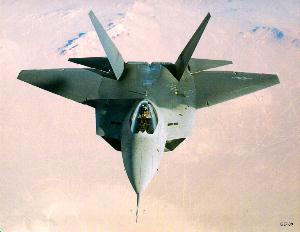F-22 ADVANCED TACTICAL FIGHTER

The Lockheed-Martin F-22 Raptor represents the greatest advance in fighter-aircraft capability in 50 years. It brings the largest increase in sustained speed since the advent of the jet, flying most of its missions at speeds other fighters can only attain for short periods. The F-22 Raptor can also, using its advanced thrust-vectoring system and supercruise capability, accelerate and maneuver at speeds today's fighter jets struggle to maintain in a straight line.
The F-22 equals, and probably surpasses, the agility of any other fighter. Its stealth characteristics which descend from the success of the F-117 stealth fighter and B-2 stealth bomber provide invisibility against most radars and sensors. Its integrated avionics, equal in power to seven Cray supercomputers, and sensor-fused displays are a generation ahead of anything under test elsewhere.
The F-22's primary mission is air superiority, defined by the USAF as "the ability to achieve local air control at a time and place of our own choosing." The odds are in favor of the side with the faster aircraft with greater range, operating under the fewest artificial constraints. The Raptor's secondary goal is to destroy as many of the enemy's front-line fighters as possible for the smallest possible number of losses.
The F-22 is designed to be immune to deep stalls - stalls from which the aircraft can't recover from with normal control outputs - and to recover from high-alpha, post-stall conditions with both engines flamed out. The F-22 is also the first fighter to be designed from the outset to use vectored thrust for control. While thrust-vectoring isn't used to expand the flight envelope, it does help the aircraft get from one maneuver state to another more quickly.
| Description | ||
|---|---|---|
| Manufacturer: | Lockheed-Martin | |
| Designation: | F-22 Raptor | |
| Type: | Advanced Tactical, Air-Superiority Fighter | |
| Specifications | ||
| Length: | 62' 1" | 18.92 M |
| Height: | 16' 7" | 5.05 M |
| Wingspan: | 44' 6" | 13.56 M |
| Wing Area: | 840 ft² (78 M²) | |
| Weights | ||
| Operational Empty: | 31700 lbs | 14375 Kg |
| Internal Fuel: | 25000 lbs | 11400 Kg |
| Clean Take-off: | 60000 lbs | 27200 Kg |
| Maximum Take-off: | 80000 lbs | 36300 Kg |
| Propulsion | ||
| No. of Engines: | 2 | |
| Powerplant: | Pratt & Whitney F-119-PW-100 augmented turbofans | |
| Bypass Ratio: | 0.2:1 | |
| Intermediate Power: | 26000 pounds each engine (116 kN) | |
| Augmented Power: | 39000 pounds each engine (173 kN) | |
| Performance | ||
| Range: | 750 NM | 1400 Km |
| Max Speed: |
Mach 1.8 - Mach 2.0 Apparently capable of a Mach 3 performance |
|
| Armanents | ||
|
six AIM-120 AMRAAMs, two AIM-9X Sidewinders, M61A2 Gatling Gun,
fuselage bays can each hold a 1,000 lb bomb instead of two AMRAAMs |
||